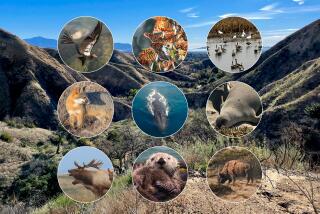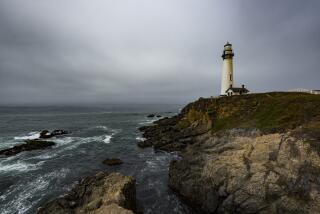Simple Pleasures on the Hood Canal
SEATTLE, Wash. ŌĆö Spend time with transplanted Pacific Northwesterners and, sooner or later, one of them will start to rhapsodize about Washington state. You know--the rhododendrons are lush, the houses are cheap, the people are real, the quality of life is. . . .ŌĆØ
Apparently beyond description, because the phrase usually ends in a wistful sigh.
But donŌĆÖt dismiss Washington worship as an utter exaggeration until youŌĆÖve visited Hood Canal. Spend a few days there at the foot of the Olympic Mountains, eating oysters on the beach to the barking of the harbor seals, and youŌĆÖll know why so many Californians seem ready to trade perpetual sunshine for frequent drizzle.
The canal, named for an 18th-Century British admiral, is not a man-made canal but a narrow, fiord-like arm of Puget Sound, the enormous body of water that shears the Olympic Peninsula from the rest of Washington state.
Hood Canal, 60 miles long and an average of about two miles wide, stretches from Port Ludlow on the north to Potlatch on the south, then takes a short northeasterly hook toward Belfair.
By California standards the canal is uninhabited, even in summer. Sail or motor over the smooth expanse of protected blue water, the glacier-covered peaks of the Olympics towering above you, and yours is likely to be the only boat in view.
Choose a chunk of waterfront from among dozens of oyster-strewn beaches; youŌĆÖll be the only one there.
For hikers, Olympic National Park is just minutes away by car. Mt. Olympus rises 7,965 feet in the center of the park, surrounded by more than a dozen slightly lesser peaks. Hundreds of miles of trails meander through remote rain forests and along mountain streams: the Quinault, the Dosewallips, the Elwha and others.
People with wet suits brave the 45- to 55-degree temperatures and water ski in the canal. Because of its isolation from ocean currents, the water is rarely choppy. On the warmest days in the summer, children swim--without wet suits--in some of the shallow, sheltered coves.
Others journey to Hood Canal for skin diving. Some of the largest octopuses in the world, weighing as much as 90 pounds and with arm spans of up to 18 feet, have been collected in the waters of Puget Sound. Watching a giant Pacific octopus emerge from a two-inch crack in a rock is said to be one of the more memorable scuba-diving experiences.
But for me, the main reason to visit Hood Canal is to eat. The place is a paradise for seafood lovers.
Oysters Piled Three Deep
The last time we were there, in late June, we took a 12-foot motorboat up the canal, about a mile and a half from our resort, and pulled up at a beach where the oysters were piled two and three deep.
Turquoise water lapped at the shore. As it receded at low tide we saw obese purple and orange sea stars, milky white sea anemones and clumps of bearded black mussels. Clams spat at us through holes in the mud.
Our children spent the morning gathering miniature green, red and brown hermit crabs. There are said to be 27 species of hermit crabs in the Puget Sound area, and the kids must have found all of them.
The four adults present--my parents, my husband and I--gathered our legal limit of oysters (18 per person) within minutes. We shucked them on the spot (itŌĆÖs illegal to remove oyster shells from the beaches), motored back to the resort with our oyster catch in plastic bags and pulled up the three crab nets we had put down earlier in the day.
Three large orange dungeness crabs and five smaller, red-and-brown rock crabs were making a meal of the quartered chickens weŌĆÖd tied inside the rings as bait.
That night we sauteed oysters and boiled crab in the kitchen of our cottage for dinner. We made another oyster run the next morning, this time staying long enough to dig for clams, too. The crab nets were full again on our return.
Day 2ŌĆÖs menu was oyster stew for lunch and steamed clams and pasta with clam sauce for dinner. My brother made crab omelets for everyone the following morning.
We had cracked crab, fresh from the crab pots, again for dinner on Day 3.
Though others golf, we ate our way around Hood Canal. There are courses at the Alderbrook Inn & Resort in Union, where we stayed, and at the Resort at Port Ludlow in Port Ludlow.
Two-Hour Trip
Although Hood Canal is just 20 miles west of Seattle, getting there from the Seattle area takes a couple of hours. The Bremerton peninsula and widest part of the sound separate the two.
Your choices are to take Interstate 5 south from Seattle, a circuitous and not particularly scenic route that winds around the southern end of Puget Sound through Tacoma and Olympia--about a two-hour drive. Or you can drive onto a ferry in Seattle and get off in Bremerton. From Bremerton itŌĆÖs a short drive to most destinations on the canal.
Accommodations on and near Hood Canal range from cheap to reasonable. WeŌĆÖve stayed at the Sunrise Motel & Resort in Hoodsport, a funky two-story building right on Washington 101. What it lacks in architectural distinction it makes up for in price, convenience and view.
Two-room suites with kitchens and balconies overlooking the canal start at $49.50. Double rooms start at $39.50. ThereŌĆÖs a pier for tying up boats and dropping crab pots. The beach at Potlatch State Park is a couple of miles south. A trail entrance to Olympic National Park is a few miles west.
The pricier Alderbrook Inn Resort, just off Washington 106 at the southernmost tip of Hood Canal, can more legitimately call itself a resort. Its 18-hole golf course and nearby tennis courts offer a stunning view of the Olympics; a full-size swimming pool, enclosed in a tropical plant-filled greenhouse, sits right on the beach.
ThereŌĆÖs also a sauna, hot tub, Ping-Pong/video game room, restaurant and bar. A lawn by the beach has a swing set for kids. ThereŌĆÖs free moorage at the pier for guests.
The motel units at Alderbrook, which start at $72 for a double room in the summer, are unexceptional. A better bet are the two-bedroom cottages that sleep six or more. These start at $110 in summer. If you can, get one of the two on the waterfront.
One warning: At all costs, avoid Alderbrook on weekends. On our last trip we stayed there Monday through Saturday. Until Friday afternoon we had the place practically to ourselves, and it was idyllic. But starting at about 4 p.m. Friday, herds of people arrived.
Dreadful Band
Soon afterward a dreadful live band began playing loud rock ŌĆśnŌĆÖ roll on the balcony in the main lounge. It continued until 1 a.m. Our quiet Northwest retreat turned into a singles bar.
For campers there are sites at Kitsap Memorial State Park, Belfair State Park and Twanoh State Park on the eastern shore of the canal, and Potlatch State Park and Dosewallips State Park on the western shore.
If youŌĆÖre after oysters, clams, crabs or mussels, choose a campsite on the eastern shore. ThereŌĆÖs less convenient road access to those beaches, and the shellfish are therefore less picked over.
Another alternative: Camp in the national forest and take day-trips to Hood Canal. The Staircase Recreation Area is the campground closest to Hood Canal.
The weather, weŌĆÖve found, is much nicer than Washingtonians would like us Californians to think. Along with your favorite shellfish recipes, pack sunscreen.
-- -- --
For more information about Hood Canal:
--Olympic National Park Service, 600 E. Park, Port Angeles, Wash. 98362. Call (206) 452-4501, Ext. 230.
--Washington State Parks and Recreation Commission, 7150 Clean Water Lane, Olympia, Wash. 98504.
--Olympic Peninsula Travel Assn., P.O. Box 625, Port Angeles, Wash. 98362-0112.
More to Read
Sign up for The Wild
WeŌĆÖll help you find the best places to hike, bike and run, as well as the perfect silent spots for meditation and yoga.
You may occasionally receive promotional content from the Los Angeles Times.






